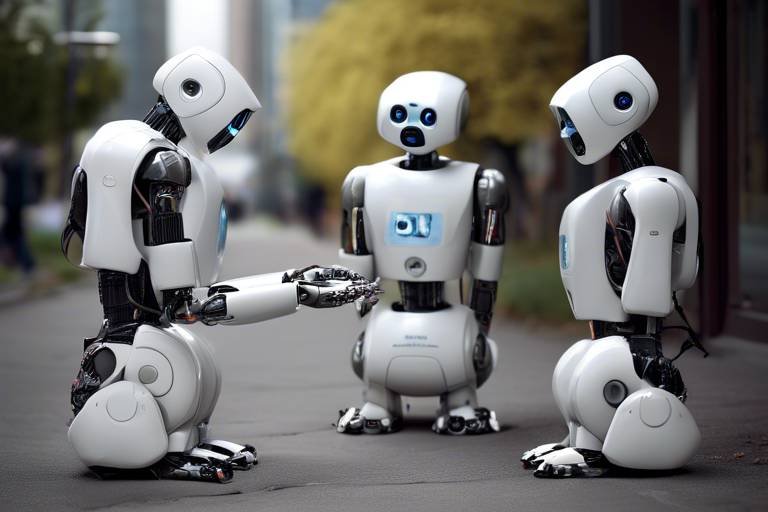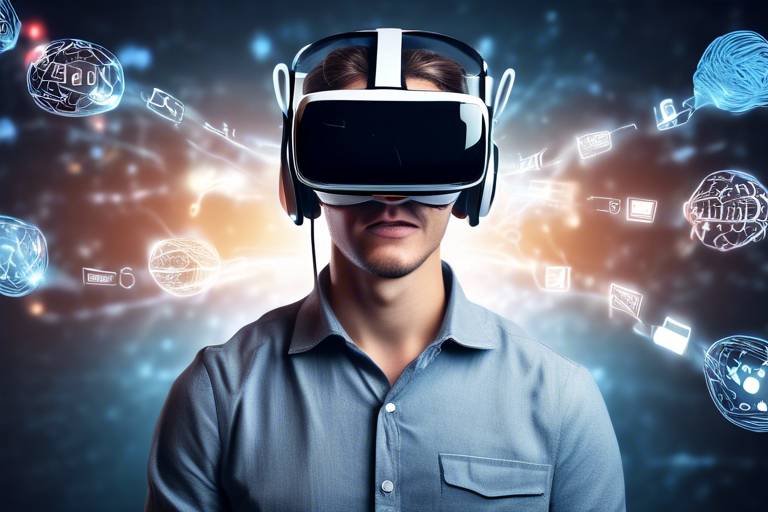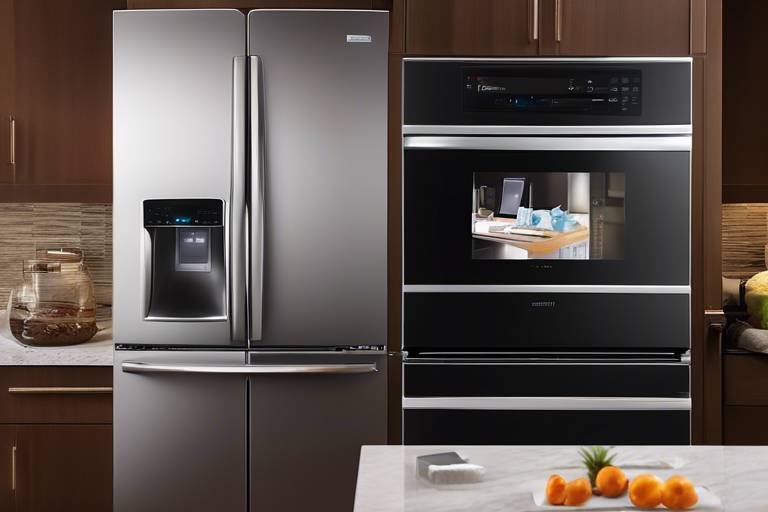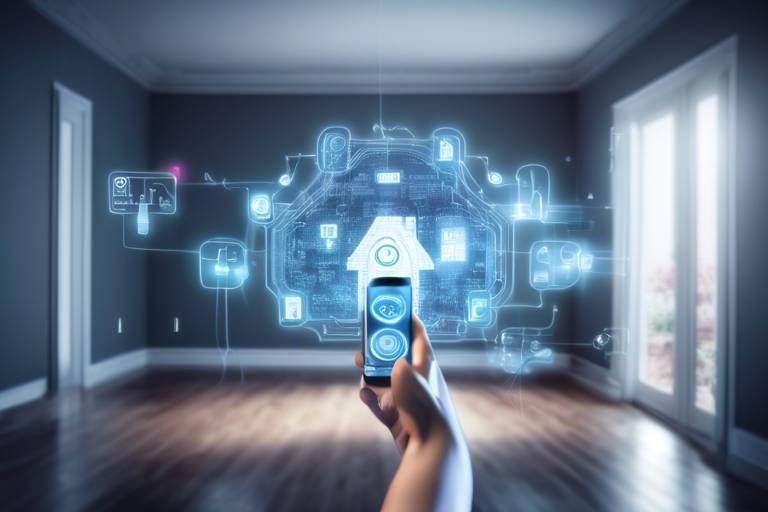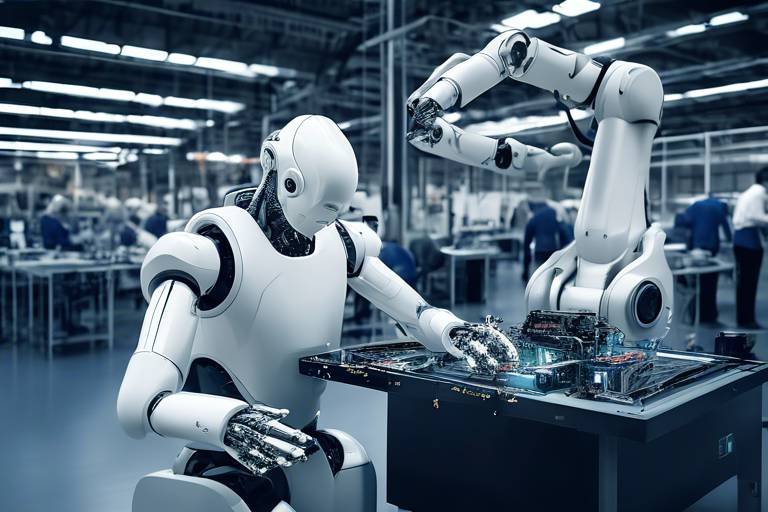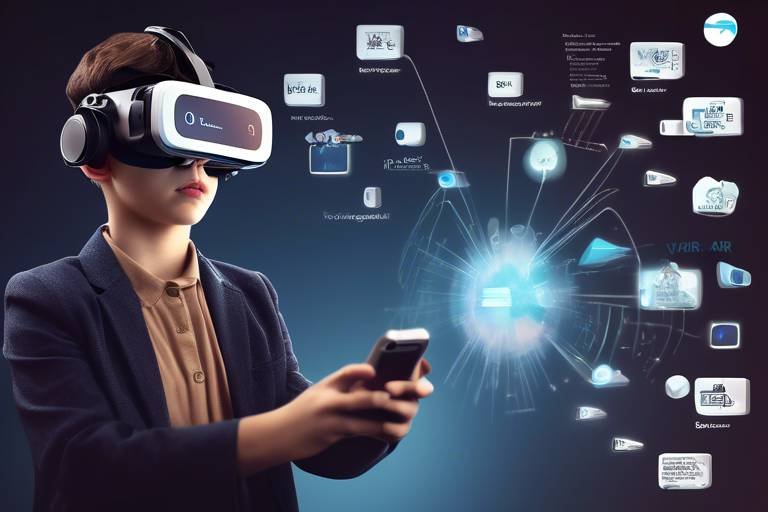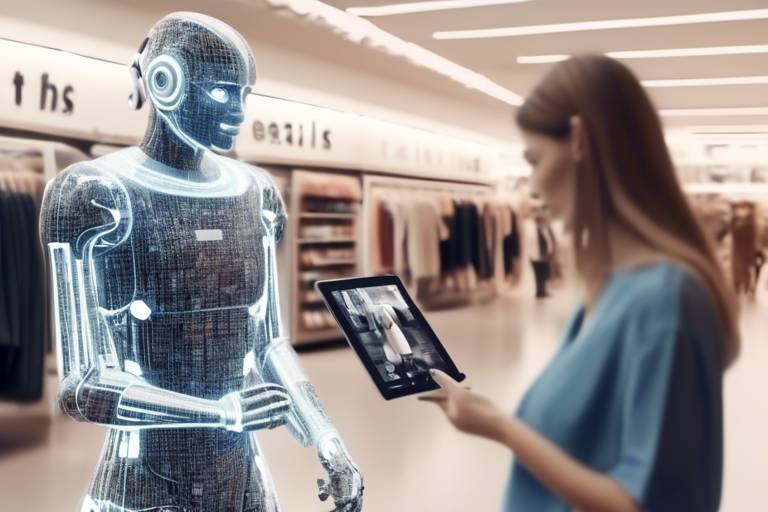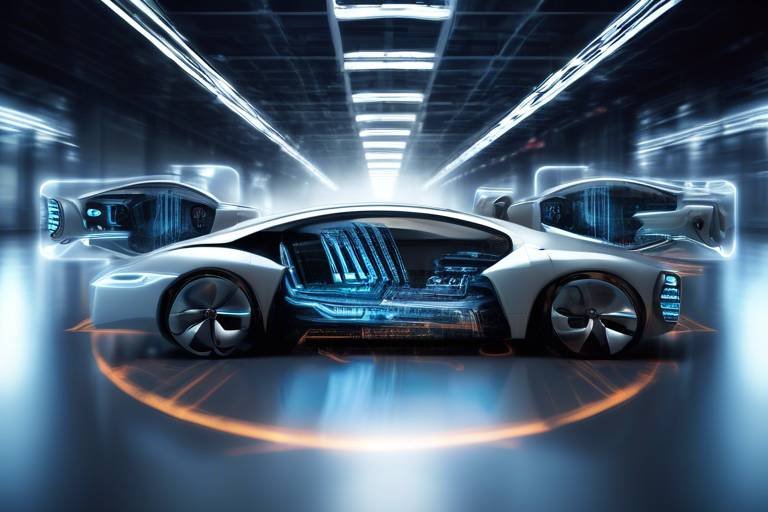Personal Robots: Helping Hands in Everyday Life
In today's fast-paced world, where time is often a luxury, personal robots are emerging as game-changers in our daily lives. Imagine coming home after a long day, and instead of facing a mountain of chores, you find everything in order, thanks to your trusty robotic assistant. These machines are not just about convenience; they represent a significant leap toward a future where technology seamlessly integrates into our homes, enhancing our quality of life.
From the moment they wake us up with a gentle nudge to the time they tuck us in with reminders about our health, personal robots are becoming our helping hands. They assist us in various tasks, allowing us to focus on what truly matters—spending quality time with family, pursuing hobbies, or simply relaxing. The beauty of personal robots lies in their ability to adapt to our individual needs, offering tailored solutions that fit our lifestyles.
But how did we get here? The journey of personal robots has been nothing short of fascinating. Initially, they were simple machines designed for specific tasks, but with advancements in technology, they have evolved into sophisticated companions capable of learning and interacting with us. This transformation has opened up a world of possibilities, making them integral to our daily routines.
In this article, we will explore the evolution of personal robots, the various types available today, the benefits they offer, and what the future holds for these remarkable devices. Whether you're a tech enthusiast or someone looking for ways to simplify your life, understanding personal robots is essential in navigating the modern landscape of home automation.
The history of personal robots is a story of innovation and adaptation. It began in the mid-20th century with basic robotic devices that could perform repetitive tasks. Over the decades, as technology advanced, these machines became more sophisticated, incorporating elements of artificial intelligence and machine learning. Today, personal robots are capable of understanding natural language, recognizing faces, and even learning from their experiences.
As we look back, it's clear that each advancement has brought us closer to a future where robots are not just tools but companions. They are designed to understand our preferences, anticipate our needs, and provide assistance in ways that feel natural and intuitive. This evolution is a testament to human ingenuity and our desire to enhance our daily lives through technology.
Today, personal robots can be categorized into several types, each serving unique functions that cater to different aspects of our lives. Here’s a brief look at the major categories:
- Service Robots: These robots perform practical tasks, such as cleaning, cooking, and caregiving.
- Educational Robots: Designed to facilitate learning, these robots engage children in STEM subjects through interactive play.
- Companion Robots: These robots provide emotional support and companionship, particularly for the elderly or those in need.
Each type of personal robot is tailored to enhance user experience and meet specific needs, making them invaluable in modern households.
The advantages of incorporating personal robots into our lives are numerous. They not only enhance efficiency but also contribute to improved safety and overall quality of life. For instance, by automating mundane tasks, personal robots free up valuable time, allowing individuals to focus on more meaningful activities. Imagine spending less time cleaning and more time enjoying a hobby or connecting with loved ones!
Moreover, many personal robots come equipped with safety features that monitor surroundings and assist vulnerable populations. This capability provides peace of mind for users and their families, especially when caring for the elderly or those with special needs.
As technology continues to advance, the future of personal robots looks incredibly promising. The incorporation of artificial intelligence and machine learning will enable these robots to learn from user interactions, becoming more intuitive and responsive over time. Imagine a robot that not only remembers your preferences but also anticipates your needs before you even ask!
However, the rise of personal robots also presents challenges. Issues such as privacy concerns and the need for ethical considerations are paramount. As we embrace this technology, it’s essential to educate users on how to maximize the potential of personal robots while ensuring their safety and security.
Q1: What tasks can personal robots perform?
A1: Personal robots can assist with a variety of tasks, including cleaning, cooking, providing companionship, and even offering healthcare support.
Q2: Are personal robots safe for children?
A2: Yes, many personal robots are designed with safety features to ensure they are safe for children to interact with. However, supervision is always recommended.
Q3: How do personal robots learn?
A3: Personal robots utilize artificial intelligence and machine learning algorithms to learn from user interactions, allowing them to adapt to individual preferences and routines.
Q4: What are the privacy concerns associated with personal robots?
A4: Privacy concerns primarily revolve around data collection and surveillance. It's crucial to understand how personal robots manage and protect user data.

The Evolution of Personal Robots
The journey of personal robots is nothing short of fascinating. It all began in the early 20th century when the concept of robots was more of a dream than a reality. The term "robot" itself was first coined in 1920 by Czech writer Karel Čapek in his play "R.U.R." (Rossum's Universal Robots). These early notions of robots were often depicted as mechanical beings performing menial tasks, but they lacked the intelligence and functionality we associate with personal robots today.
Fast forward to the late 20th century, when technological advancements began to pave the way for more sophisticated machines. The introduction of microprocessors and sensors allowed robots to perform specific tasks with greater precision. In the 1990s, we saw the emergence of simple robotic vacuum cleaners, which marked the beginning of robots entering our homes. These devices, while basic, offered a glimpse into a future where robots could take on household chores and free up our time.
As we moved into the 21st century, personal robots evolved dramatically. The integration of artificial intelligence (AI) and machine learning transformed these machines from simple automatons into smart companions capable of understanding and responding to human needs. Today, personal robots are not just tools; they are becoming integral parts of our daily lives. From robotic vacuum cleaners to advanced healthcare assistants, these machines are designed to enhance our living experience.
To illustrate the evolution of personal robots, consider the following timeline:
| Year | Milestone |
|---|---|
| 1920 | Term "robot" introduced in Karel Čapek's play. |
| 1996 | First robotic vacuum cleaner introduced. |
| 2000s | Rise of home automation and smart technologies. |
| 2010s | Introduction of AI in personal robots for enhanced interaction. |
| 2020s | Advanced personal robots with healthcare and educational capabilities. |
This evolution has not only made personal robots more versatile but has also expanded their roles in various aspects of life. For instance, service robots are now commonplace in homes, offering assistance with cleaning, cooking, and even caregiving. Meanwhile, educational robots are engaging children in learning through interactive play, fostering creativity and critical thinking skills. The future looks bright as we continue to innovate and integrate these remarkable machines into our daily routines.
As we look ahead, it's clear that personal robots will continue to evolve, becoming smarter and more capable. The integration of AI and machine learning will allow them to learn from their environments and adapt to our preferences, making them even more valuable companions in our lives. The evolution of personal robots is a testament to human ingenuity and the relentless pursuit of convenience and efficiency in our everyday activities.

Types of Personal Robots
In today's fast-paced world, personal robots have carved out a significant niche in our daily lives, transforming how we approach various tasks. These robots can be broadly categorized into several types, each designed to fulfill specific functions and cater to different needs. Whether you're looking for a reliable helper around the house, a companion for your children, or an educational tool to foster learning, there's a personal robot out there for you. Let's dive deeper into the fascinating world of personal robots and explore the different categories that are making waves in modern households.
The first category we encounter is service robots. These handy machines are designed to assist with everyday tasks, making life a little easier and freeing up time for more enjoyable activities. From vacuuming your floors to preparing meals, service robots cover a wide range of functions. Among the most popular service robots are:
- Home Cleaning Robots: These robots, such as the Roomba, have revolutionized the way we clean our homes. They navigate through spaces, avoiding obstacles while efficiently picking up dirt and debris. Imagine coming home to a spotless floor without lifting a finger!
- Healthcare Assistance Robots: These robots are particularly beneficial for the elderly or individuals with medical needs. They can remind users to take their medications, monitor vital signs, and even provide companionship, ensuring that no one feels alone in their journey.
Next, we have educational robots, which are designed to engage children and young learners in the exciting world of STEM (Science, Technology, Engineering, and Mathematics). These robots often incorporate interactive play into their design, making learning fun and engaging. For instance, robots like LEGO Mindstorms allow kids to build and program their own machines, fostering creativity and problem-solving skills. With educational robots, learning becomes an adventure rather than a chore, inspiring the next generation of innovators.
Another fascinating category is companion robots, which are designed to provide emotional support and companionship. These robots can engage in conversations, play games, and even help alleviate feelings of loneliness. For example, robots like PARO, a therapeutic robot designed to resemble a baby seal, are used in care facilities to provide comfort to patients. The gentle interaction with these robots can significantly enhance the emotional well-being of individuals, particularly the elderly.
As we explore the diverse types of personal robots, it's clear that they are not just gadgets; they are companions, helpers, and educators that enhance our lives in numerous ways. With each category serving a unique purpose, personal robots are becoming essential tools that improve convenience and efficiency in our everyday routines.
| Question | Answer |
|---|---|
| What is a personal robot? | A personal robot is a machine designed to assist individuals in daily tasks, enhancing convenience and efficiency in various aspects of life. |
| What are service robots? | Service robots perform specific tasks such as cleaning, cooking, and caregiving, providing practical assistance to individuals and families. |
| How do educational robots help children? | Educational robots engage children in STEM subjects through interactive play, fostering creativity and problem-solving skills. |
| Are personal robots safe? | Many personal robots come equipped with safety features to prevent accidents and monitor surroundings, providing peace of mind for users. |

Service Robots
Service robots are revolutionizing the way we manage our daily tasks, acting as our personal assistants in various aspects of life. Imagine coming home after a long day, only to find that your house has been cleaned, dinner is prepared, and your medications are organized. Sounds like a dream, right? Well, this is the reality that service robots are creating. These advanced machines are designed to perform a multitude of tasks that not only save time but also enhance the quality of our lives.
From cleaning to cooking and even caregiving, service robots are tailored to meet the specific needs of individuals and families. They are equipped with sophisticated sensors and algorithms that allow them to navigate their environments, making them incredibly efficient in completing their designated tasks. For instance, home cleaning robots can effortlessly glide across floors, detecting dirt and debris while avoiding obstacles. This automation not only ensures a spotless home but also gives users more time to enjoy life, whether that means spending time with loved ones or engaging in hobbies.
When it comes to healthcare, service robots play a pivotal role in supporting individuals with medical needs. They can remind users to take their medications, monitor vital signs, and even provide companionship to the elderly. These robots are designed to be user-friendly, often featuring intuitive interfaces that make them accessible to people of all ages. The integration of technology into healthcare not only enhances the quality of care but also fosters independence among users, allowing them to live more fulfilling lives.
Moreover, the versatility of service robots is impressive. They can be programmed for various tasks, making them suitable for different environments, including homes, hospitals, and offices. Here’s a quick look at some of the most popular types of service robots:
| Type of Service Robot | Functionality |
|---|---|
| Home Cleaning Robots | Automate cleaning tasks like vacuuming and mopping. |
| Healthcare Assistance Robots | Provide medication reminders and health monitoring. |
| Delivery Robots | Transport goods and packages within various settings. |
| Companion Robots | Offer social interaction and support for the elderly. |
As we look towards the future, the role of service robots will only expand. With advancements in artificial intelligence and machine learning, these robots will become even more capable and responsive to our needs. Imagine a robot that can learn your preferences for cleaning or cooking, adapting its methods to suit your lifestyle. The possibilities are endless, and as these technologies evolve, so too will our reliance on service robots in our everyday lives.
- What tasks can service robots perform? Service robots can handle a variety of tasks, including cleaning, cooking, delivering items, and providing healthcare assistance.
- Are service robots safe to use? Yes, most service robots are equipped with safety features that prevent accidents and ensure user safety.
- How do service robots learn? Many service robots use artificial intelligence and machine learning to adapt to user preferences and improve their functionality over time.
- Can service robots replace human jobs? While service robots can automate certain tasks, they are designed to assist humans rather than completely replace them.

Home Cleaning Robots
Home cleaning robots have revolutionized the way we maintain our living spaces, bringing a level of convenience and efficiency that was once the stuff of science fiction. Imagine coming home after a long day at work, kicking off your shoes, and knowing that your floors have already been vacuumed and mopped by a little automated helper. These robots, often equipped with advanced sensors and smart technology, can navigate through your home, avoiding obstacles and ensuring that every corner is spotless. It's like having a tiny, tireless housekeeper that never complains!
One of the most popular types of home cleaning robots is the robotic vacuum cleaner. These nifty gadgets have become household staples, with brands like Roomba, Neato, and Roborock leading the charge. They utilize a combination of suction power and brushes to capture dust, dirt, and pet hair, making them ideal for busy families and pet owners alike. The best part? Many of these devices can be programmed to clean on a schedule, so you can set them to work while you're out running errands or enjoying a day at the park.
But it's not just about vacuuming anymore. Home cleaning robots have evolved to include mopping functionalities, with models that can switch between dry vacuuming and wet mopping. This dual-action capability means you can achieve a deeper clean without lifting a finger. Just think about how much time you’ll save! Instead of spending your weekends scrubbing floors, you can enjoy more leisure time with family and friends.
Here’s a quick comparison of some popular home cleaning robots:
| Model | Features | Price Range |
|---|---|---|
| iRobot Roomba 980 | Wi-Fi connected, app control, voice commands, carpet boost | $600 - $800 |
| Neato Botvac D7 | Laser mapping, zone cleaning, app control, no-go lines | $600 - $700 |
| Roborock S5 | Vacuum and mop, smart mapping, app control, long battery life | $400 - $600 |
While home cleaning robots offer significant advantages, it's essential to understand their limitations as well. They may not be able to tackle larger messes or deep-clean carpets like traditional vacuum cleaners. However, they excel at maintaining cleanliness on a day-to-day basis, allowing you to keep your home tidy without the constant effort. Plus, many models come with features such as self-charging capabilities, meaning they can return to their docking station to recharge once their battery runs low, ensuring they’re always ready for the next cleaning session.
In conclusion, home cleaning robots are more than just gadgets; they are practical solutions that fit seamlessly into our busy lives. Whether you’re a parent juggling multiple responsibilities, a professional with a hectic schedule, or simply someone who values a clean home, these robots can help lighten your load. By investing in a home cleaning robot, you’re not just buying a device; you’re gaining back precious time to spend on the things that truly matter.
- How do home cleaning robots navigate around my home? Most home cleaning robots use a combination of sensors, cameras, and mapping technology to navigate and avoid obstacles.
- Can I control my robot vacuum with a smartphone? Yes, many modern home cleaning robots come with smartphone apps that allow you to schedule cleanings and monitor their progress.
- Are home cleaning robots effective on carpets? Yes, many models are designed to work effectively on carpets, but their performance may vary based on the type of carpet and the robot's suction power.
- How often should I run my home cleaning robot? It depends on your lifestyle, but many users find that running their robot daily or every other day helps maintain a clean home.

Healthcare Assistance Robots
In today's fast-paced world, are emerging as vital companions for individuals with medical needs. These robots are not just machines; they are designed to enhance the quality of life for the elderly, disabled, and those managing chronic conditions. Imagine a world where your medication reminders are taken care of, where your health is monitored continuously, and where companionship is just a voice command away. This is the reality that healthcare assistance robots are creating.
One of the primary roles of these robots is to provide medication management. They can remind patients when to take their medications, ensuring that no doses are missed. This is especially crucial for elderly individuals who may struggle with memory issues. By automating this process, healthcare assistance robots reduce the risk of medication errors and promote adherence to treatment plans.
Moreover, many of these robots come equipped with advanced sensors and monitoring systems. They can track vital signs such as heart rate, blood pressure, and even blood glucose levels. This real-time data can be invaluable for both patients and healthcare providers, allowing for timely interventions when necessary. For example, if a robot detects an irregular heartbeat, it can alert the user or their healthcare provider, potentially preventing a serious health crisis.
But it’s not just about monitoring health; these robots also provide companionship. Loneliness can be a significant issue for many elderly individuals, and healthcare assistance robots can help bridge that gap. Equipped with conversational abilities, they can engage users in dialogue, play games, or even tell stories. This interaction can greatly improve mental well-being, providing a sense of connection and reducing feelings of isolation.
In addition to these functions, healthcare assistance robots can assist with daily activities, such as helping individuals get out of bed, reminding them to exercise, or guiding them through rehabilitation exercises. These capabilities not only foster independence but also encourage a proactive approach to health management.
As we look to the future, the integration of artificial intelligence and machine learning will only enhance the effectiveness of healthcare assistance robots. They will become more personalized, adapting to the unique needs and preferences of each user. This evolution will transform how we view healthcare, making it more accessible and tailored to individual needs.
However, with these advancements come important considerations. Issues related to privacy, data security, and ethical use of technology must be addressed. Users must feel confident that their personal health information is protected and that they are in control of their interactions with these robots.
Overall, healthcare assistance robots represent a significant leap forward in supporting individuals with medical needs. They combine technology and compassion, offering not just practical assistance, but also emotional support. As they continue to evolve, we can expect them to play an increasingly prominent role in our healthcare systems, ultimately enhancing the quality of life for many.
- What are healthcare assistance robots? Healthcare assistance robots are automated devices designed to help individuals with medical needs by providing medication reminders, monitoring health conditions, and offering companionship.
- How do these robots monitor health? Many healthcare assistance robots are equipped with sensors that track vital signs such as heart rate and blood pressure, and they can alert users or caregivers if any abnormalities are detected.
- Can these robots help with daily activities? Yes, healthcare assistance robots can assist with a variety of daily tasks, including reminding users to take medications, helping with mobility, and encouraging physical activity.
- Are healthcare assistance robots safe to use? While these robots are designed with safety in mind, it is essential for users to understand how to operate them properly and to ensure that their data is secure.

Educational Robots
In today's fast-paced world, are revolutionizing the way children learn, making education not just informative but also incredibly engaging. Imagine a classroom where students are not just passive recipients of information but active participants in their learning journey. Educational robots serve as interactive tools that spark curiosity and foster creativity in young minds. They are designed to enhance STEM (Science, Technology, Engineering, and Mathematics) education by providing hands-on experiences that traditional teaching methods often lack.
These robots come in various forms, each tailored to meet specific learning objectives. For instance, some robots are programmed to teach coding through playful challenges, allowing children to grasp complex programming concepts while having fun. Others focus on robotics and engineering, encouraging students to build and program their own robots, thereby enhancing their problem-solving skills and critical thinking. The beauty of educational robots lies in their ability to adapt to different learning styles, ensuring that every child can benefit from this innovative approach to education.
Furthermore, educational robots promote collaboration among students. When children work together to program a robot or solve a problem, they learn valuable teamwork skills that are essential in today’s interconnected world. This collaborative aspect not only makes learning more enjoyable but also prepares them for future challenges in the workplace. As they navigate through tasks, they develop communication skills, patience, and resilience, which are all crucial traits for personal and professional success.
To give you a clearer picture, here’s a quick overview of some popular educational robots and their key features:
| Robot Name | Primary Function | Age Group |
|---|---|---|
| LEGO Mindstorms | Building and programming robots | 10+ |
| Bee-Bot | Introduction to coding | 4-8 |
| Sphero | Programming through play | 8+ |
| Dash and Dot | Interactive learning and coding | 5-10 |
As we look toward the future, the potential for educational robots is limitless. With advancements in artificial intelligence and machine learning, these robots will become even more sophisticated, providing personalized learning experiences that cater to the unique needs of each student. Imagine a robot that can assess a child’s learning pace and adjust its teaching methods accordingly! This level of customization could transform education, making it more effective and accessible for everyone.
In conclusion, educational robots are not just gadgets; they are powerful tools that can transform the landscape of learning. As they continue to evolve, they promise to bridge the gap between traditional education and the skills needed for the future. By integrating fun and learning, educational robots are paving the way for a new generation of innovators and thinkers. So, the next time you see a child engrossed in programming a robot, remember that they are not just playing; they are building the future!
- What age group is best for educational robots? Educational robots cater to various age groups, from preschoolers to high school students, with different robots designed for specific learning levels.
- Are educational robots expensive? Prices vary, but there are many affordable options available, making them accessible for schools and families.
- Do I need prior programming knowledge to use educational robots? No, many educational robots are designed for beginners and come with user-friendly interfaces and tutorials.
- How can educational robots enhance learning? They provide hands-on experiences, promote collaboration, and help develop critical thinking and problem-solving skills in students.

Benefits of Personal Robots
Personal robots have swiftly transitioned from the realm of science fiction into our everyday lives, and the benefits they bring are nothing short of revolutionary. Imagine a world where mundane tasks are handled effortlessly, allowing you to focus on what truly matters. These robotic assistants are designed not just to perform chores but to enhance our overall quality of life. They help us reclaim precious time, reduce stress, and even improve our safety at home. But how exactly do they achieve this? Let’s dive deeper into the myriad advantages of personal robots.
One of the most significant benefits of personal robots is their ability to save time. In today’s fast-paced world, time is often our most valuable resource. Personal robots excel at automating repetitive tasks, such as cleaning or cooking, which can free up hours in your week. For instance, a home cleaning robot can vacuum your floors while you spend time with family or pursue hobbies. This automation not only enhances productivity but also leads to a more organized and less stressful living environment. Imagine coming home to a spotless house without having lifted a finger!
Another compelling advantage is the enhanced safety features that many personal robots offer. These robots are equipped with sensors and cameras that help them navigate their surroundings safely. For example, healthcare assistance robots can monitor the elderly, reminding them to take medications or alerting family members in case of emergencies. This capability not only provides peace of mind for families but also empowers individuals to live independently for longer. The integration of safety features means that vulnerable populations can enjoy a higher quality of life without compromising their well-being.
Moreover, personal robots contribute to our overall well-being by providing companionship, especially for those who may feel isolated. Companion robots are designed to engage users in conversation, play games, or even provide reminders for social activities, helping to combat loneliness. For many, these robots become more than just tools; they evolve into trusted companions that enhance emotional health. The impact of such interactions can be profound, as they encourage social engagement and foster a sense of belonging.
To summarize, the benefits of personal robots can be highlighted as follows:
- Time-Saving: Automating tasks allows for more leisure time.
- Enhanced Safety: Features that monitor and assist vulnerable populations.
- Improved Well-Being: Companionship and emotional support through interaction.
As we look toward the future, it’s essential to recognize that while personal robots offer numerous advantages, they are not without their challenges. However, the potential they hold to transform our daily lives is undeniable. By embracing these innovations, we can enhance our efficiency, safety, and overall quality of life, making personal robots invaluable assets in modern households.
Q1: How much do personal robots typically cost?
A1: The cost of personal robots can vary widely based on their functionality and features, ranging from a few hundred to several thousand dollars.
Q2: Are personal robots easy to use?
A2: Most personal robots are designed with user-friendliness in mind, featuring intuitive interfaces and simple setup processes. Many come with apps that allow for easy control and monitoring.
Q3: Can personal robots really improve my quality of life?
A3: Absolutely! By taking over mundane tasks, providing companionship, and enhancing safety, personal robots can significantly improve your daily life and overall well-being.

Time-Saving Advantages
In our fast-paced world, time is a precious commodity. With the hustle and bustle of daily life, who wouldn't want a little extra time to relax or spend with loved ones? This is where personal robots come into play, acting as our trusty sidekicks in the quest for efficiency. By automating mundane tasks, these robots can significantly reduce the time we spend on chores, allowing us to focus on what truly matters.
Imagine coming home after a long day, only to find that your personal cleaning robot has already vacuumed and mopped the floors. You can kick back, enjoy a cup of tea, and unwind instead of dreading the thought of cleaning. This is just one example of how personal robots can transform our daily routines. Here are some key ways they save time:
- Automation of Household Chores: Robots can handle repetitive tasks like vacuuming, dusting, and even doing laundry. This automation means you can spend your evenings doing something you love rather than cleaning.
- Streamlined Meal Preparation: Cooking robots can assist in meal prep, chopping vegetables, and even cooking entire meals, which means less time in the kitchen and more time enjoying your dinner.
- Efficient Scheduling: Personal assistants powered by AI can help manage your calendar, reminding you of appointments and deadlines, ensuring you never miss a beat.
Furthermore, consider the impact of these time-saving advantages on your overall quality of life. With the hours saved from routine tasks, individuals can invest more time in personal growth, hobbies, or simply enjoying time with family. The benefits extend beyond just convenience; they can lead to improved mental health and a more balanced lifestyle.
It's also worth noting that the time saved can be substantial. For example, a robot vacuum can save an average of 30 minutes a day, which adds up to over 180 hours a year! That’s equivalent to more than a week of vacation time. Imagine what you could do with that extra time! Whether it's picking up a new hobby, spending time with friends, or just enjoying some well-deserved rest, the possibilities are endless.
In conclusion, personal robots are not just futuristic gadgets; they are practical solutions designed to enhance our daily lives. By taking over time-consuming tasks, they allow us to reclaim our time, making life not only easier but also more enjoyable. As we embrace these technological advancements, we pave the way for a future where we can focus on living, rather than merely existing.
Q: How do personal robots save time?
A: Personal robots automate mundane tasks such as cleaning, cooking, and scheduling, allowing individuals to focus on more meaningful activities.
Q: Are personal robots easy to use?
A: Yes! Most personal robots are designed with user-friendly interfaces and can be easily programmed or controlled via smartphone apps.
Q: What types of tasks can personal robots perform?
A: Personal robots can perform a variety of tasks including vacuuming, cooking, caregiving, and even providing companionship.
Q: Will personal robots replace human jobs?
A: While personal robots may automate certain tasks, they are designed to assist humans rather than replace them, allowing people to focus on more complex and creative endeavors.

Enhanced Safety Features
In today's fast-paced world, safety is more important than ever, and personal robots are stepping up to the plate in remarkable ways. These modern marvels come equipped with an array of designed to protect users and create a secure environment at home. Imagine having a personal assistant that not only helps with chores but also keeps an eye on your well-being. Sounds like science fiction, right? Well, it's becoming a reality!
One of the primary safety features of personal robots is their ability to monitor surroundings. Equipped with advanced sensors and cameras, these robots can detect obstacles, identify hazards, and navigate through your home without causing any damage. This is particularly beneficial for families with young children or pets, as it reduces the risk of accidents significantly. For instance, a robot vacuum can intelligently map your living space, avoiding stairs and fragile items, ensuring that your little ones and furry friends are safe while it cleans.
Moreover, personal robots also play a crucial role in health monitoring. For elderly individuals or those with medical conditions, certain robots are designed to remind users to take their medications on time, monitor vital signs, and even alert caregivers in case of emergencies. This feature is invaluable for families who may not always be present to check on their loved ones. With a robot by their side, seniors can maintain their independence while feeling secure, knowing that help is just a button press away.
Another exciting aspect of personal robots is their ability to integrate with smart home systems. This connectivity enables them to communicate with other devices and respond to potential safety threats. For example, if a smoke detector goes off, a personal robot can alert the household and even guide residents to safety. This level of integration not only enhances safety but also provides peace of mind, knowing that your home is equipped with a vigilant assistant.
In addition to these features, many personal robots come with emergency response capabilities. Some models are programmed to recognize distress signals or falls, allowing them to contact emergency services or designated family members immediately. This feature is a game-changer for those who may experience health issues or accidents at home, as it ensures timely assistance when it matters most.
As we embrace the future of personal robotics, it's essential to acknowledge the potential challenges that come with these technologies. While the benefits are undeniable, concerns about privacy and data security must be addressed. Users should be educated on how to operate these devices safely and securely, ensuring that their personal information remains protected while they enjoy the advantages of enhanced safety features.
In conclusion, the enhanced safety features of personal robots are not just a luxury; they are becoming a necessity in our daily lives. By providing monitoring, health assistance, smart home integration, and emergency response capabilities, these robots are transforming our homes into safer spaces. As technology continues to evolve, we can only imagine the innovative solutions that await us, making personal robots indispensable allies in our quest for a secure and convenient lifestyle.
- What types of safety features do personal robots have? Personal robots often include obstacle detection, health monitoring, emergency response capabilities, and smart home integration.
- Can personal robots help elderly individuals? Yes, many personal robots are designed specifically to assist the elderly by reminding them of medications, monitoring health, and providing companionship.
- Are personal robots secure in terms of data privacy? While personal robots have advanced features, users should be aware of privacy settings and ensure their data is protected.
- How do personal robots communicate with smart home devices? Personal robots can connect to smart home systems via Wi-Fi or Bluetooth, allowing them to interact and respond to various devices in the home.

The Future of Personal Robots
The future of personal robots is an exhilarating topic that sparks the imagination and ignites curiosity. As technology continues to advance at a breakneck pace, the possibilities for personal robots seem almost limitless. Imagine a world where your robot not only understands your commands but anticipates your needs before you even voice them. This isn't just a dream—it's rapidly becoming a reality. With innovations in artificial intelligence and machine learning, personal robots are set to evolve into even more intuitive and responsive companions.
One of the most exciting prospects is the integration of AI and machine learning into personal robots. This means that rather than simply following pre-programmed instructions, these robots will have the ability to learn from their interactions with users. They will adapt to individual preferences, making them more efficient and personalized in their tasks. For example, a cooking robot could learn your favorite recipes and even adjust them based on your dietary restrictions. It’s like having a personal chef who knows your tastes inside and out!
Yet, as we embrace this technological revolution, it’s essential to consider the challenges that come with it. The rise of personal robots brings forth several ethical considerations and privacy concerns. For instance, as robots become more integrated into our lives, they will inevitably collect data about our habits and routines. This raises questions about who owns that data and how it’s used. Additionally, there’s the concern of how much autonomy we grant these machines. Striking a balance between convenience and control will be crucial as we navigate this new frontier.
Moreover, user education will play a pivotal role in maximizing the potential of personal robots. As these machines become more sophisticated, users will need to understand how to interact with them effectively. This might involve learning how to program them, troubleshoot issues, or even just understand their capabilities. Providing accessible resources and support will be vital in ensuring that everyone can benefit from these advancements.
In summary, the future of personal robots is not just about enhancing our daily lives; it’s about transforming the way we interact with technology. With the right balance of innovation and ethical considerations, personal robots could become indispensable partners in our homes. They promise to save us time, enhance our safety, and significantly improve our quality of life. As we stand on the brink of this exciting evolution, one thing is clear: the journey of personal robots is just beginning, and the best is yet to come.
- What are personal robots? Personal robots are automated machines designed to assist individuals with daily tasks, enhancing convenience and efficiency.
- How do personal robots learn? Many personal robots utilize AI and machine learning to adapt to user preferences and improve their functionality over time.
- What are the ethical concerns surrounding personal robots? Key concerns include privacy issues related to data collection and the need for clear guidelines on the autonomy of robots.
- Will personal robots be affordable? As technology advances and production scales, it's expected that personal robots will become more affordable for the average consumer.

AI and Machine Learning Integration
The integration of artificial intelligence (AI) and machine learning into personal robots is nothing short of revolutionary. Imagine a personal assistant that not only understands your commands but also learns your preferences over time. This evolution is akin to nurturing a plant; with the right care and attention, it grows stronger and more capable. Personal robots equipped with AI can analyze user interactions and adapt their functionalities, making them more intuitive and responsive to our needs.
Consider this: a home cleaning robot that recognizes which areas of your home require more frequent cleaning based on your daily activities. Instead of relying solely on pre-set schedules, these robots can learn from patterns, ensuring that your living space remains spotless without you lifting a finger. This is just one of the many ways AI enhances the user experience.
Moreover, the potential for machine learning to transform personal robots extends beyond mere convenience. With advancements in natural language processing, these robots can engage in more meaningful conversations. Picture having a chat with your robot companion that feels less like talking to a machine and more like conversing with a friend. This capability not only fosters a deeper connection but also enables robots to provide tailored support, whether it’s reminding you of important tasks, offering emotional support, or even sharing the latest news.
However, the integration of AI and machine learning isn't without its challenges. As these robots become more autonomous, issues around privacy and security come to the forefront. Users must be educated about how their data is used and the importance of safeguarding personal information. Moreover, ethical considerations arise, prompting discussions on the boundaries of AI capabilities and the potential for dependency on these machines.
To summarize, the integration of AI and machine learning into personal robots is a game-changer. It not only enhances their functionality but also enriches our interactions with them. As we embrace this technological advancement, we must remain vigilant about the implications it brings, ensuring that we harness the full potential of these innovative companions while addressing the challenges they present.
- What are personal robots? Personal robots are automated machines designed to assist individuals in various tasks, enhancing convenience and efficiency in daily life.
- How do AI and machine learning improve personal robots? AI and machine learning allow personal robots to learn from user interactions, making them more adaptive and responsive to individual needs.
- What are some examples of personal robots? Examples include home cleaning robots, healthcare assistance robots, and educational robots that engage children in learning.
- Are there privacy concerns with personal robots? Yes, as personal robots collect and process data, there are concerns about how this information is used and stored.
- Will personal robots replace human jobs? While personal robots can automate certain tasks, they are more likely to complement human efforts rather than completely replace jobs.

Potential Challenges and Considerations
As we embrace the convenience of personal robots, it's crucial to recognize the potential challenges and considerations that come along with this technological evolution. One of the primary concerns is privacy. Personal robots often collect data to learn and adapt to user preferences. This data can include sensitive information about daily routines and habits, raising questions about who has access to this data and how it is protected. For instance, if a robot records when you leave for work or when you're home alone, this information could be misused if it falls into the wrong hands.
Another significant challenge lies in the realm of ethical considerations. As robots become more integrated into our lives, we must ponder their impact on human relationships. Will we become overly reliant on these machines, potentially diminishing our social interactions? The line between companionship and automation blurs when robots begin to fulfill roles traditionally held by friends or family members. It’s vital to consider how these changes affect our emotional well-being and societal structures.
Furthermore, the need for user education cannot be overstated. Many people may find it challenging to adapt to new technologies, especially older adults who may not be as tech-savvy. To maximize the potential of personal robots, we must ensure that users are adequately educated on how to operate these devices, understand their functionalities, and recognize their limitations. Without proper education, users may face frustration or even misuse the technology, leading to safety concerns.
Lastly, there are also financial implications to consider. While personal robots can save time and enhance efficiency, the initial investment can be substantial. Individuals and families must weigh the costs against the benefits, determining whether a personal robot is a worthwhile addition to their household. As technology evolves, we may see a decrease in prices, but for now, affordability remains a barrier for many.
In summary, while personal robots offer exciting opportunities for enhancing our daily lives, we must approach their integration with caution. Addressing privacy, ethical concerns, education, and financial implications will be crucial to ensuring that these machines serve as beneficial companions rather than sources of anxiety or dependency.
- What are personal robots? Personal robots are automated devices designed to assist with various tasks in daily life, ranging from cleaning to companionship.
- How do personal robots enhance safety? Many personal robots come equipped with sensors and monitoring systems that can help prevent accidents and provide assistance to vulnerable populations.
- Are personal robots expensive? The cost of personal robots can vary widely depending on their capabilities and features, but they can represent a significant investment for many households.
- What are the main concerns about personal robots? Key concerns include privacy issues, ethical implications, the need for user education, and financial considerations.
Frequently Asked Questions
- What are personal robots?
Personal robots are automated machines designed to assist individuals in their daily tasks. They come in various forms, such as cleaning robots, educational robots, and healthcare assistants, each tailored to enhance convenience and efficiency in everyday life.
- How do personal robots improve daily life?
These robots save time and effort by automating mundane chores like cleaning and cooking. They can also provide companionship and support for the elderly or individuals with medical needs, ultimately improving the quality of life for users.
- Are personal robots safe to use?
Yes, most personal robots are equipped with safety features designed to prevent accidents and monitor their surroundings. This is especially beneficial for vulnerable populations, providing peace of mind for users and their families.
- What types of personal robots are available?
There are several types of personal robots, including service robots for household tasks, educational robots that engage children in learning, and companion robots that offer emotional support. Each type serves a unique purpose to enhance user experience.
- How do educational robots aid in learning?
Educational robots engage children in STEM subjects through interactive play, fostering creativity and problem-solving skills. They make learning fun and can adapt to various learning styles, making education more accessible and enjoyable.
- What does the future hold for personal robots?
The future looks bright, with advancements in artificial intelligence and machine learning. These technologies will enable personal robots to learn from user interactions, becoming more intuitive and responsive, potentially revolutionizing how we integrate them into our daily lives.
- What challenges do personal robots face?
Despite their benefits, personal robots come with challenges such as privacy concerns and ethical considerations. It's essential for users to be educated on these issues to maximize the potential of their robotic companions while ensuring safety and security.

